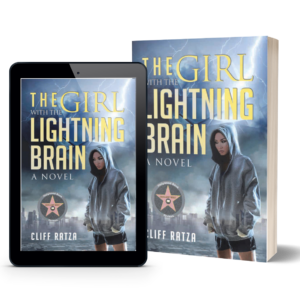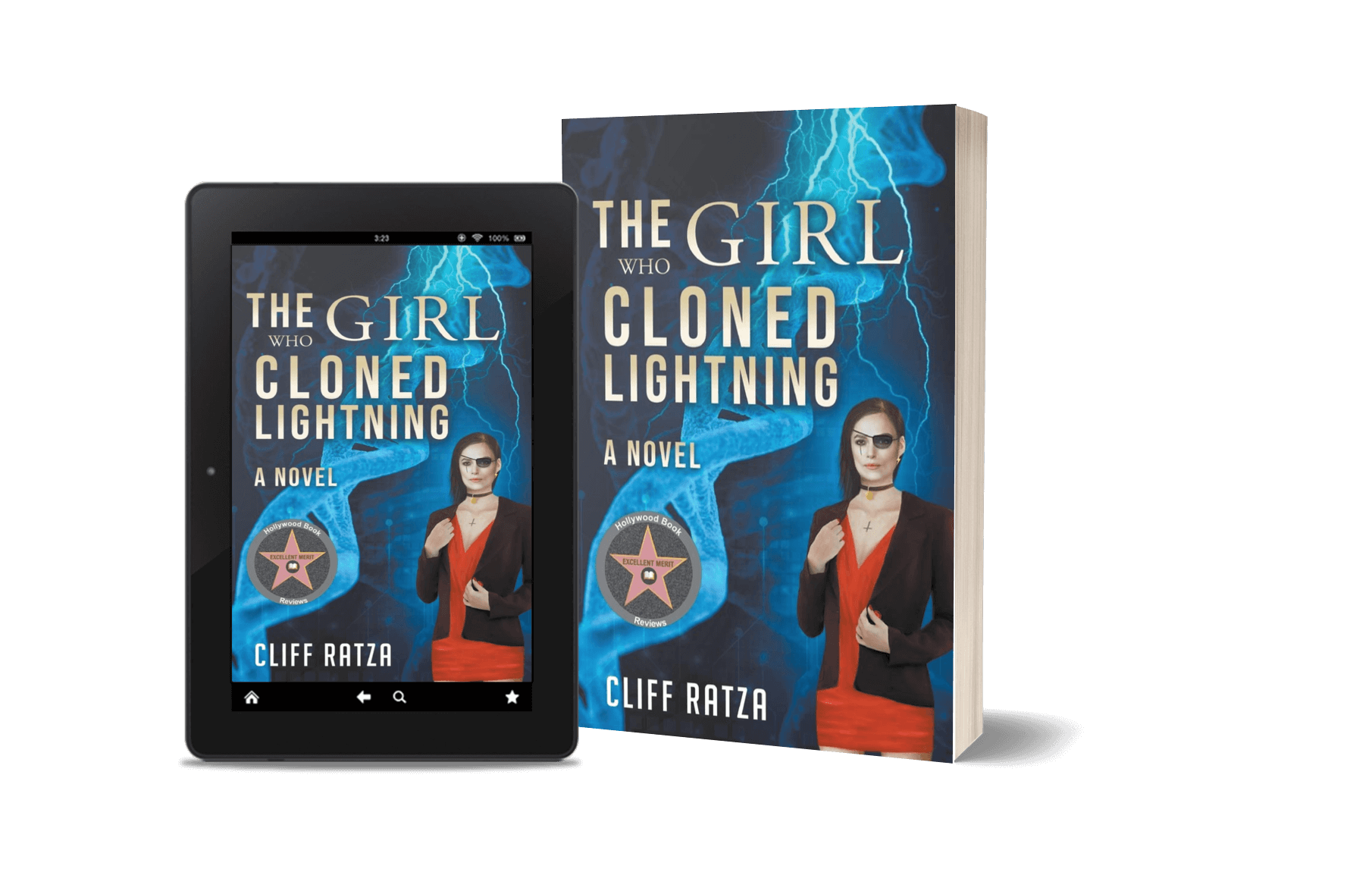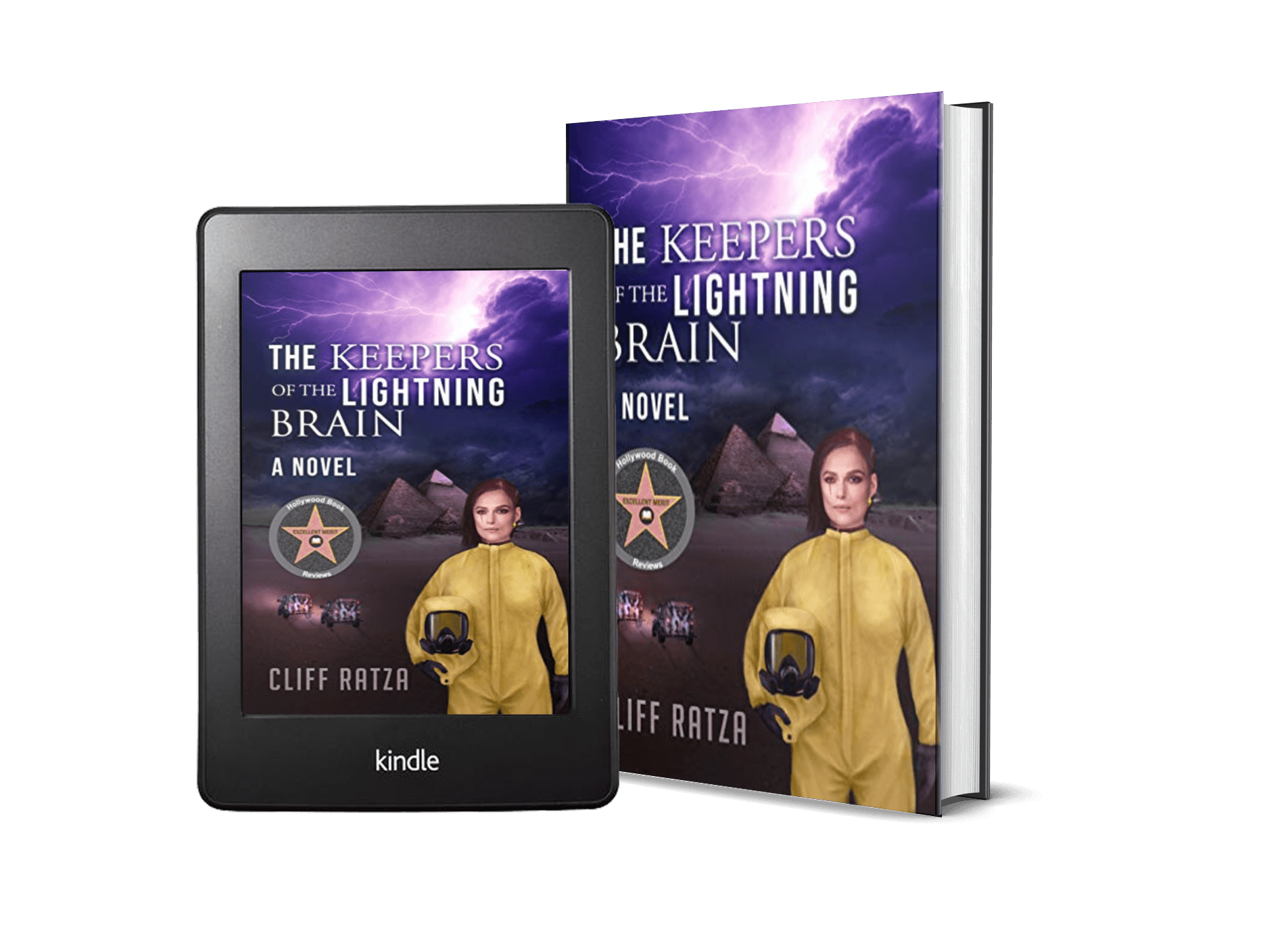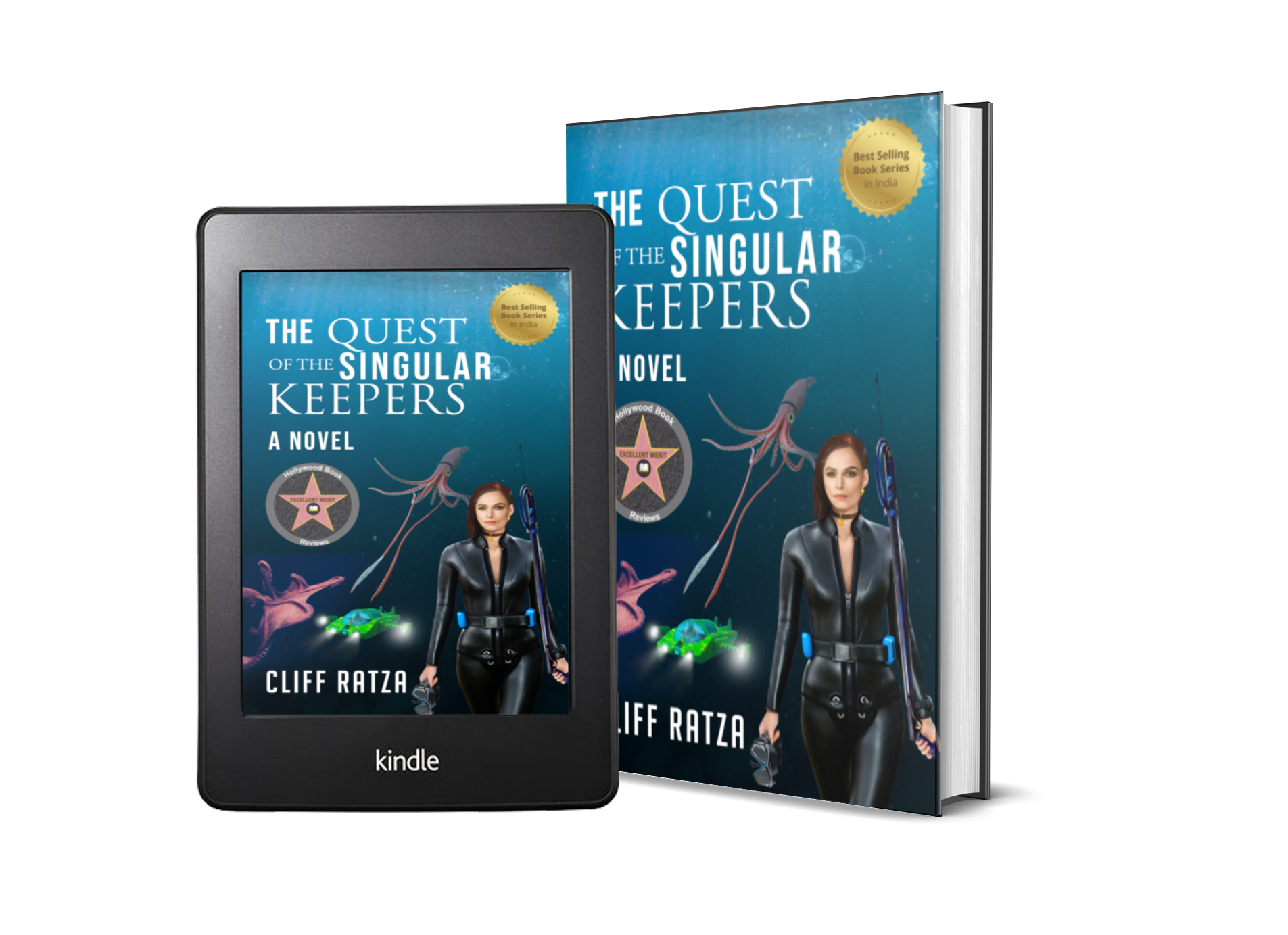Foundation Principles for the Lightning Brain Series
Introduction
Although an intricate foundation is not necessary for readers to enjoy a fiction series, having one might extend the breadth and depth of their enjoyment. Literary series rather than those written for mainstream categories are more apt to have one, and if a contemporary series does, it might increase the amount of preparatory time and effort before the reader can “dive into” the first novel. Because contemporary lifestyles place deadlines and constraints, only the highly motivated reader might be willing to put up with this rigamarole.
Not so for the Lightning Brain Series! Its foundation is every bit as sophisticated as those found in the best literary series, but readers will discover as much of it as they want simply by reading the books at whatever depth they wish:
- Gripping action-packed thriller
- Glimpse into a plausible near-term future
- Insight into dealing with the “human condition”
- Illustrative optimistic and pragmatic worldview philosophy
- Fast-paced, suspense-filled emotive narrative and imagery
- Introduction to topics every reader wants to know
- Interesting talking points going beyond sound-bites
What follows is a comprehensive description of our Lightning Brain Series foundation. Please read as much as you wish, and come back for more if it suits you. After all, only you can decide what best meets your needs.
Overarching Principles
Our series is supported by integrated factual theories and findings that go well beyond those found in other speculative, sci-fi, or dystopian novels. Here are bullet points summarizing the most salient:
- DNA, which dictates neuroscience, controls all aspects of man’s three personas: the Physical, the Emotional, and the Cognitive.
- Life emerged over billions of years from random changes in an organic (carbon-based) substrate. Its rules are encapsulated in DNA, and it has only one prime directive: to survive by transmitting genetically favorable traits to its offspring.
- Humans are the most advanced link in an evolutionary chain. Language distinguishes Humanity from all other species and allows for cognitive growth (attributable to science and technology) that exceeds what evolution can handle.
- Smart as humans are, Humanity has asymptotic limits to what can be comprehended. The limits are imposed by the brain’s hardware (neurons and interneural connections) and software (the language people use to communicate). Though there are limits, man can continually improve, advancing incrementally.
- Man is a problem-solving Social Animal that is predisposed to believe in a God and whose traits are 50-50 Nature versus Nurture. Man splits his allegiance between the one (individual) and the many (tribe). Mankind’s thinking and acting are consistent among all races and cultures. Any differences between males and females are caused by X versus Y chromosomes.
- Even though Man is ostensibly superior to prehistoric ancestors, their DNA is essentially identical. The Flynn effect (a population’s I.Q. increases decade by decade) is a matter of technological improvements
Philosophical Ramifications
These principles lead to profound considerations for all activities, Humanity’s philosophical investigations being perhaps the most far reaching. For our purposes, a relevant chronological summary of Western philosophies (linear) follows. Eastern philosophies (cyclic/holistic/eternal) – Confucianism, Hinduism, Buddhism, etc. – have much to offer but are not included. The German Philosopher Arthur Schopenhauer is the first Western philosopher to study Eastern philosophies.
Ancient or Classical Philosophy (2000 BCE – 0 CE)
Before philosophy, humans had only myth and superstition to explain the world they inhabited. Greece, the cradle of Western philosophy, reached a zenith during the Golden Age (Democritus, Socrates, Plato, Aristotle, etc.) All branches emerged (Metaphysics, Ontology, Epistemology, Ethics, Esthetics, Politics), accompanied by a remarkably accurate description of reality (“Atoms and the Void,” Idealism, Materialism, Values, Relativism). Who knows what greater heights they might have reached had they possessed a better technology?
Greece gave way to Rome, which accommodated Christianity. Exemplar philosophers Saint Augustine and Boethius attempted to integrate Christianity into Greco-Roman Philosophy. What little progress was being made halted when Rome fell. 0 CE to 500 CE is labeled the Dark Ages.
Medieval Period (500 – 1500)
Illiteracy hindered philosophical extension. The rise of Islam (Muhammad) and a handful of thinkers (Averroes, Saint Thomas Aquinas, Maimonides, Machiavelli, Spinoza) continued integrating religion into philosophy while balancing “faith versus reason” and locating the individual’s place in a world they were just beginning to understand.
Renaissance (1500 – 1650)
Philosophy regained its footing when civilization recovered enough from plagues, popes, and monarchs to consider better ways of living. Aided by the printing press and thinkers like Leonardo da Vinci, Martin Luther, Descartes and Hobbes, philosophers used the classical philosophers to pivot away from religion and authoritarian rule to the individual and the facts found via science (Roger and Francis Bacon, Copernicus). They began to consider the secular rather than spiritual.
Enlightenment/Scientific Revolution (Neoclassicism (1650 – 1850)
Now that philosophy had reawakened, thinkers like Newton, Locke, Mill, Smith, Voltaire, Darwin, and Montesque opened new vistas to philosophers, who accelerated Renaissance trends. Led by Immanuel Kant, Hegel, and Schopenhauer, philosophy adjusted the places that Faith/Religion and Reason/Rationality fit, as well as the roles of theoretical versus empirical knowledge. It also began to consider the psychological dimension.
Philosophers of this period believed in progress, freedom, absolutes, truth, liberty over democracy, the individual over the group, rational thinking over faith, and the perfectibility of man.
Modernity (Industrial Revolution 1850 – 1945)
Technology and its impact on great European thinkers powered dramatic changes in business, economics, and social order, French and American revolutions and British Imperialism being the most obvious manifestations. German thinkers and philosophers – Hegel, Husserl, Heidegger, Rousseau, Nietzche, Marx, Freud – took the lead, criticizing the dehumanizing aspects of Capitalism and Technology, exploring “a Turn to the Subject” versus Objectivity, and considering Truth, Reality and Values to be contingent on context.
Cracks began to appear in the Enlightenment’s veneer; early 20th century philosophers and philosophical offshoots – Romanticism, Realism, the Vienna Circle, Logical Positivism, Pragmatism, Bertrand Russell, Ludwig Wittgenstein, William James – attempted to patch them, but the disturbing science and logic of Einstein, Heisenberg, and Godel, coupled with two cataclysmic World Wars and ecological threats, brought Modernity to an end.
Postmodern Philosophy (1949 to 1989)
After viewing the disastrous results caused by applying Modern Philosophy, many philosophers abandoned the optimistic Enlightenment principles – Absolutes, Socioeconomic Progress, Objectivity, Liberty, Individualism, Rationalism, Science – and stated new ones that make the “Human Condition” fragmented, uncertain, and meaningless – Negativism, Nihilism, and valueless Existentialism. Everything becomes relative as each person defines Reality, Being, and Truth. All this, when added to Power, Inequality, and Identity conflict became centerpieces for philosophers like Sarte, Foucault, Derrida, Lyotard, Kuhn, and Rorty. But they offered no way out of their dystopian funk.
Post-Postmodern Philosophy (Neoconservatism 1989 –)
Contrary to what postmodern philosophers were preaching, the world didn’t end. Philosophers who believed Enlightenment principles could be salvaged regrouped to rein in their exuberant excesses and adjust them for man’s limits. Chief among them are Noam Chomsky and Richard Rorty, who address the problems of Linguistics, and Leo Strauss, who combines the best of Ancient and Modern philosophies to forge a neoconservative economic and political order meant to be satisficing, not optimizing.
And that’s where philosophy is today. I can think of a better name for it: Neuro-Syn Philosophy, but we’ll leave the name game to the next generation. America in the early 21th century has used it to be the most resilient nation for rebounding from “the Great Recession,” domestic inequality and technological threats, climate or sustainability issues, and challenges to its “Superpower status.” America’s future is contingently optimistic. It remains the best place to be.
So, where does that leave Americans? Still pragmatic and looking ahead, but often skeptical of government, business, and academic institutions, often questioning so-called “subject matter experts.” Still demanding freedom and liberty supported by a democratic-style government that promotes diversity and reduces inequality. Still interested in getting ahead while helping others. Still guardedly trusting technology but concerned about its darker side. America and its people remain an exciting work in progress.
Takeaways for Religion and Science
Humanity dropped myth and superstition by morphing them into the security of religion and faith, but progress made in last millennium has weakened the Church. Spirituality decreases; Secularism and Humanism increase as Science and Technology shrink the radius of Religion. A healthy debate between the “two cultures” continues. Both sides finally agree that it is a fool’s errand to debate the “Big Three” questions: Is there a God? How did Life and the Universe begin? Is there Purpose? Though many in Europe have “moved beyond” religion, America is the most religious of First World nations, and the Middle East, where Islamism and Theocracy dominate, continue a millennium-long war against Christianity.
Progress in science and technology have pushed civilization forward, providing tools that give man better insight into the laws of Nature. Enlightenment and early 20th century thinkers believed man would ultimately unravel all of Nature’s mysteries.
That belief has been scaled back. Even mathematics, the bedrock of science, has built-in inconsistencies. Today, the best Man can do is acknowledge its asymptotic limits to what can be known. Advances in bio and computer technology will empower people to grapple with larger problems involving harder equations and more complexity, but won’t bust through boundaries built by DNA.
So, how is America coping? We are promoting religious freedom, diversity, and respect for the individual. We realize that although some areas of science and technology – high energy physics in particular – are close to an asymptotic limit, others – notably genetic engineering and AI computing – are still young and offer significant progress. We have many reasons to be optimistic if we act intelligently.
Implications for Economics and Politics
The Enlightenment unleashed the power of Free Enterprise, Capitalism, and price-driven Market Economies. Their confluence led to demonstrably stunning improvements in overall quality of life. However, their excesses lead to winners and losers.
The Enlightenment also created a better form of government: a democratic Republic answering to the will of the people instead of popes or monarchs. But economics and politics are inextricably linked, negating the possibility of an “End of History.” There is no final destination of a democratic, capitalistic, and market-driven economy in which people are free and equal.
Today, though the Soviet Union struggles to regain a place on the world stage, there is a challenging alternative to America’s politico-economic model: China. Can its directed economy actually control economic growth? Can its authoritarian government manage resources better than America’s democratic system of checks and balances?
So, how is America responding? By promoting policies meant to broaden business objectives, include all stakeholders, narrow inequality, and reduce partisan politics. By voting into office public servants who practice civility and cooperation, and by fostering a spirit of global cooperation that will prove once again that the American system, though not perfect, is the “last best hope” as long as America stays proactive, resilient, and smart.
Whither the Lightning Brain Series?
Built on this foundation, our series gives readers a refreshingly new set of novels. It goes well beyond the sci-fi, speculative, or dystopian fiction being written today, and it lifts characters and plots found in current literary novels out of their angst-riddled problems found in the “human condition” and puts them in a better place. Unlike many current novels, each book in the series puts no extraordinary demands on the reader’s perseverance. All should enjoy their clarity, style and pace.
So, what’s in store for readers? A profound and enchanting near-term future explored though characters and plot that should draw them in from page one of novel number one: The Girl With The Lightning Brain. Does it succeed? Let the readers decide!
BOOK 1
THE GIRL WITH THE LIGHTNING BRAIN
“Electra is exceptional. She knows that. And she also knows her extraordinary abilities – the paranormal aftermath of a near-death experience at birth – are secrets that must never be revealed. Her life depends on it.”
So begins chapter one in book one of the ground-breaking “Lightning Brain” action-adventure series that extrapolates the latest science, political intrigue, and contemporary lifestyles while tracing the twists and turns in the life of Electra “Kit” Kittner.


BOOK 2
THE GIRL WHO ELECTRIFIED THE WORLD
“Mrs. T struggled mightily to maintain composure… Her head felt like an overinflated balloon… she had struggled even harder to salvage a rescue mission… to retrieve what’s needed to keep America safe from the Techno-Plague, Middle East Terrorism, and the Guardian Party.”
Can Electra keep her “secret” hidden while allowing males to play her deadly games as her array of extraordinary skills deepens? You won’t find out until the last line of the last chapter!
BOOK 3
THE GIRL WHO COMMANDED LIGHTNING
Book three picks up where book two’s “Death Vigil” ends. The lightning brain must repair itself before Electra can rejoin the battle against the Techno-Plague as well as contend with war raging in Cyberspace directed by a rogue Middle East state allied with China and Russia, all the while dealing- with America’s relentlessly harsh government.
How the lightning brain and Electra’s emergent personalities struggle to win is a page-turning plot, full of action and suspense to the very end!


Book 4
The Girl Who Cloned Lightning
This book charges ahead from Book 3’s explosive ending. Electra Kittner – now an Electra-Alisha split personality infected with an STD-like T-Plague mutation – must cure herself first before battling a new set of enemies in Cyber as well as 3-D Space.
Can she hold adversaries at bay? Find out when you read, and then you’ll know when you reach the very last line of the last chapter.
Book 5
THE GIRL WHO SPARKED THE SINGULARITY
BOOK FIVE OF LIGHTNING BRAIN SERIES ADDS NEW CHARACTERS AND MYSTERIOUS TWISTS THAT ELEVATE ACTION AND SUSPENSE LEADING TO STUNNING CONCLUSION OF ENTIRE SERIES.
“Put down weapon and praise Allah for deliverance. You are only survivor we find.”
These starting lines from chapter one launch Electra Kittner’s relentless pursuit of known adversaries and her obsessive search for an unknown hacker-leaker, plunging our protagonist into danger on every action-filled step she takes in 3-D and Cyberspace. Will she emerge unscathed? You will know only when reaching the very last line, and even then, maybe not. You decide!

Poems from Indira: Reflections through Life’s Hourglass
A wish from Indira:
My poems are written in meter and style,
Intended to make you consider or smile.
And if whimsical clarity emerges for you,
I’ve done what I hoped for my wish has come true.



Reflections from a Half-Filled Looking Glass
A wish from Indira:
I hope you find my verses giving,
A singular view that helps you see.
While on the journey that you’re living,
The joys of shared reality.

Book 6
THE KEEPERS OF LIGHTNING BRAIN
BOOK ONE OF THE “KEEPERS” SERIES SEAMLESSLY BRIDGES FROM THE END OF “THE LIGHTNING BRAIN” SERIES (FEB. 2137) TO “RIGHT NOW” (FEB. 2157) AS IT INTRODUCES A NEW SET OF CHARACTERS AND SITUATIONS UNFOLDING IN A COMPELLING STORYLINE.
Follow the suspense-filled action as Indira activates four novice Keepers who get to know themselves and each other better as they embark on an astounding rescue mission for which they understand little and even less about potentially deadly consequences. But if they are successful, not only will they bring Electra back but each will reach an epiphany that may point the way forward. Are they successful? Please read on to find out!
BOOK 7
The Keepers of Contingent World
The duo is back in action and ready to reconstruct personal and professional worlds. But new challenges await. A pandemic (the X-Virus), Cyberspace terrorism, greedy corporations, and power-hungry governments roil climates (Environmental, Health, Social, Technological, Political, Economic) as repercussions from melting polar ice caps and other disrupting events cause worldwide tectonic shifts above and below the surface.
Follow the action-adventure as the duo and her clone-children charge further into college, careers, and relationships as they struggle to be their authentic selves. Nothing is guaranteed, everything is contingent, but you can see the story come to life as this page-turning plot propels them to reach for their goals.


book 8
The Quest of the Singular Keepers
In this third book of the Keepers series, Irani-Electra duo try to balance personal and professional lives, as they continue to serve the world and uncovering conspiracies and deal with the fact that Irani’s cloned children are leading their own lives.
Irani, Electra, and Indira continue to make discoveries and developments in biotech, computer science, and cloning. And they continue to uncover insurgencies, which ultimately led to bombing the White House and killing the two highest officials in the country. All the while, Irani-Electra barely makes it out alive from her burning house.
Burnt and naked, will she survive this ordeal? Or will we see the end of her tale?
BOOK 9
The Girl Who Reset the Lightning Brain
After an 18-month hiatus post a destructive fire, Electra Kittner emerges, now as Native American Professor Electra Alisha Kirchner. Following a near fatal encounter with an international conspiracy, she reset her life in solitude. With new documentation provided by Indira the Singularity, she assumes a role as an adjunct professor at U.T. Austin specializing in Space Medicine. Former identities are abandoned, and Electra remains in the shadows to protect her loved ones. Ready to confront old and new adversaries, Electra embarks on a mission to mitigate escalating world events with Indira’s support. Join her on an action-packed journey as she navigates through unpredictable twists and turns toward an unforeseeable climax.


book 10
The Girl Who Reset the Cyber World
In “The Girl Who Reset the Cyber World,” sequel to the first book, Electra’s journey continues from where it left off. Her pivotal role in NASA’s Mars mission leads to a slew of new projects, causing stress-induced health issues she conceals. Amid tackling Climate Change challenges worldwide, Electra relies on her intellect and Indira’s androids for safety. As crises mount in her clone children’s lives, Electra’s quick thinking prevents disasters, but she faces overwhelming pressure. Struggling to cope, she falls, leaving Renee unsure how to revive her. This installment delves deeper into the Lightning Brain series’ overarching theme, highlighting the vulnerability of even the most extraordinary individuals in a world resistant to truth. It emphasizes the need for everyone to navigate the complexities of humanity while leveraging their talents and skills optimistically and pragmatically.
BOOK 11
The Girl Who Reset The 3-D World
In “The Girl Who Reset the 3-D World,” the third installment of the Reset Series, the story picks up seamlessly from the previous book. After Electra falls ill, Renee seeks Indira’s help to revive her. With the lightning brain restored, Electra relies on her network of friends to recover. However, her perspective shifts due to past adversities, leading to new challenges and alliances across various locations. Amidst rising tension and suspense, Electra faces both triumphs and losses, confronting existential threats. As the novel concludes, Electra reflects on her uncertain future, leaving the ultimate decision to her lightning brain, with even Indira uncertain of what lies ahead.
